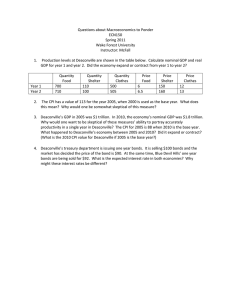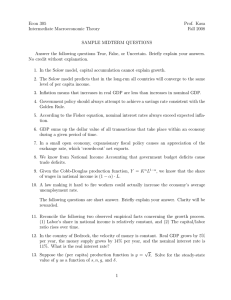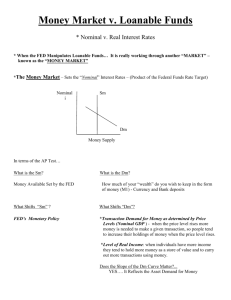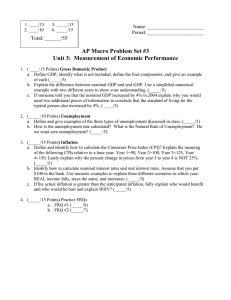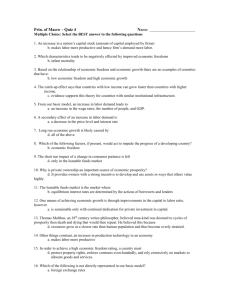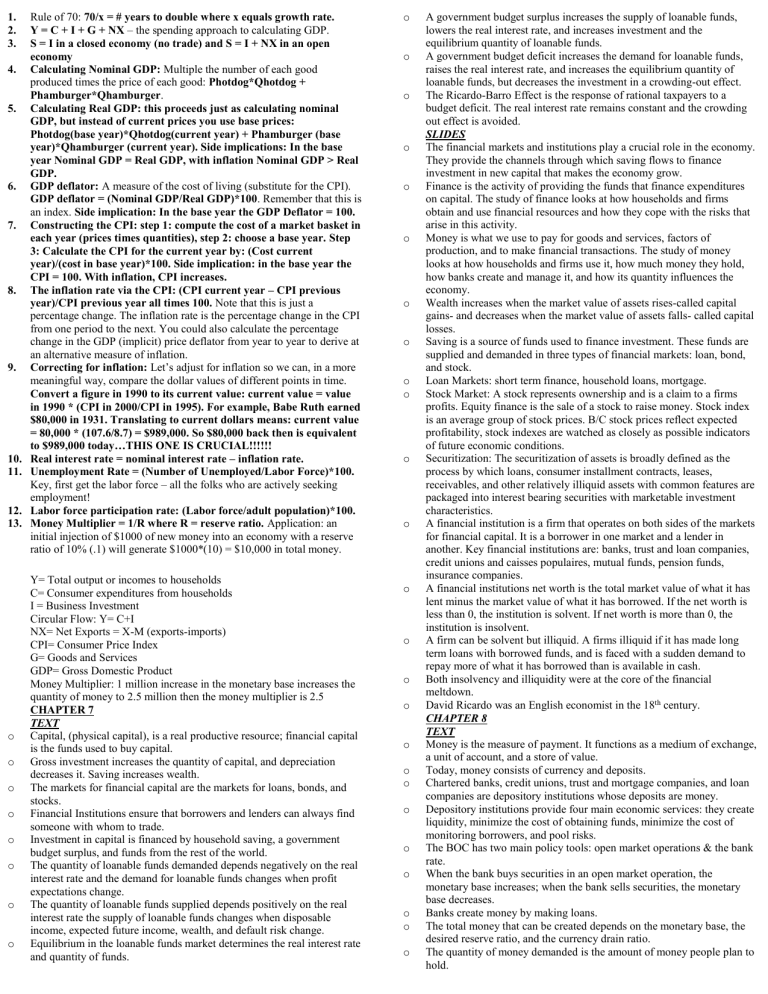
1. 2. 3. 4. 5. 6. 7. 8. 9. 10. 11. 12. 13. o o o o o o o o Rule of 70: 70/x = # years to double where x equals growth rate. Y = C + I + G + NX – the spending approach to calculating GDP. S = I in a closed economy (no trade) and S = I + NX in an open economy Calculating Nominal GDP: Multiple the number of each good produced times the price of each good: Photdog*Qhotdog + Phamburger*Qhamburger. Calculating Real GDP: this proceeds just as calculating nominal GDP, but instead of current prices you use base prices: Photdog(base year)*Qhotdog(current year) + Phamburger (base year)*Qhamburger (current year). Side implications: In the base year Nominal GDP = Real GDP, with inflation Nominal GDP > Real GDP. GDP deflator: A measure of the cost of living (substitute for the CPI). GDP deflator = (Nominal GDP/Real GDP)*100. Remember that this is an index. Side implication: In the base year the GDP Deflator = 100. Constructing the CPI: step 1: compute the cost of a market basket in each year (prices times quantities), step 2: choose a base year. Step 3: Calculate the CPI for the current year by: (Cost current year)/(cost in base year)*100. Side implication: in the base year the CPI = 100. With inflation, CPI increases. The inflation rate via the CPI: (CPI current year – CPI previous year)/CPI previous year all times 100. Note that this is just a percentage change. The inflation rate is the percentage change in the CPI from one period to the next. You could also calculate the percentage change in the GDP (implicit) price deflator from year to year to derive at an alternative measure of inflation. Correcting for inflation: Let’s adjust for inflation so we can, in a more meaningful way, compare the dollar values of different points in time. Convert a figure in 1990 to its current value: current value = value in 1990 * (CPI in 2000/CPI in 1995). For example, Babe Ruth earned $80,000 in 1931. Translating to current dollars means: current value = 80,000 * (107.6/8.7) = $989,000. So $80,000 back then is equivalent to $989,000 today…THIS ONE IS CRUCIAL!!!!!! Real interest rate = nominal interest rate – inflation rate. Unemployment Rate = (Number of Unemployed/Labor Force)*100. Key, first get the labor force – all the folks who are actively seeking employment! Labor force participation rate: (Labor force/adult population)*100. Money Multiplier = 1/R where R = reserve ratio. Application: an initial injection of $1000 of new money into an economy with a reserve ratio of 10% (.1) will generate $1000*(10) = $10,000 in total money. Y= Total output or incomes to households C= Consumer expenditures from households I = Business Investment Circular Flow: Y= C+I NX= Net Exports = X-M (exports-imports) CPI= Consumer Price Index G= Goods and Services GDP= Gross Domestic Product Money Multiplier: 1 million increase in the monetary base increases the quantity of money to 2.5 million then the money multiplier is 2.5 CHAPTER 7 TEXT Capital, (physical capital), is a real productive resource; financial capital is the funds used to buy capital. Gross investment increases the quantity of capital, and depreciation decreases it. Saving increases wealth. The markets for financial capital are the markets for loans, bonds, and stocks. Financial Institutions ensure that borrowers and lenders can always find someone with whom to trade. Investment in capital is financed by household saving, a government budget surplus, and funds from the rest of the world. The quantity of loanable funds demanded depends negatively on the real interest rate and the demand for loanable funds changes when profit expectations change. The quantity of loanable funds supplied depends positively on the real interest rate the supply of loanable funds changes when disposable income, expected future income, wealth, and default risk change. Equilibrium in the loanable funds market determines the real interest rate and quantity of funds. o o o o o o o o o o o o o o o o o o o o o o o o o A government budget surplus increases the supply of loanable funds, lowers the real interest rate, and increases investment and the equilibrium quantity of loanable funds. A government budget deficit increases the demand for loanable funds, raises the real interest rate, and increases the equilibrium quantity of loanable funds, but decreases the investment in a crowding-out effect. The Ricardo-Barro Effect is the response of rational taxpayers to a budget deficit. The real interest rate remains constant and the crowding out effect is avoided. SLIDES The financial markets and institutions play a crucial role in the economy. They provide the channels through which saving flows to finance investment in new capital that makes the economy grow. Finance is the activity of providing the funds that finance expenditures on capital. The study of finance looks at how households and firms obtain and use financial resources and how they cope with the risks that arise in this activity. Money is what we use to pay for goods and services, factors of production, and to make financial transactions. The study of money looks at how households and firms use it, how much money they hold, how banks create and manage it, and how its quantity influences the economy. Wealth increases when the market value of assets rises-called capital gains- and decreases when the market value of assets falls- called capital losses. Saving is a source of funds used to finance investment. These funds are supplied and demanded in three types of financial markets: loan, bond, and stock. Loan Markets: short term finance, household loans, mortgage. Stock Market: A stock represents ownership and is a claim to a firms profits. Equity finance is the sale of a stock to raise money. Stock index is an average group of stock prices. B/C stock prices reflect expected profitability, stock indexes are watched as closely as possible indicators of future economic conditions. Securitization: The securitization of assets is broadly defined as the process by which loans, consumer installment contracts, leases, receivables, and other relatively illiquid assets with common features are packaged into interest bearing securities with marketable investment characteristics. A financial institution is a firm that operates on both sides of the markets for financial capital. It is a borrower in one market and a lender in another. Key financial institutions are: banks, trust and loan companies, credit unions and caisses populaires, mutual funds, pension funds, insurance companies. A financial institutions net worth is the total market value of what it has lent minus the market value of what it has borrowed. If the net worth is less than 0, the institution is solvent. If net worth is more than 0, the institution is insolvent. A firm can be solvent but illiquid. A firms illiquid if it has made long term loans with borrowed funds, and is faced with a sudden demand to repay more of what it has borrowed than is available in cash. Both insolvency and illiquidity were at the core of the financial meltdown. David Ricardo was an English economist in the 18th century. CHAPTER 8 TEXT Money is the measure of payment. It functions as a medium of exchange, a unit of account, and a store of value. Today, money consists of currency and deposits. Chartered banks, credit unions, trust and mortgage companies, and loan companies are depository institutions whose deposits are money. Depository institutions provide four main economic services: they create liquidity, minimize the cost of obtaining funds, minimize the cost of monitoring borrowers, and pool risks. The BOC has two main policy tools: open market operations & the bank rate. When the bank buys securities in an open market operation, the monetary base increases; when the bank sells securities, the monetary base decreases. Banks create money by making loans. The total money that can be created depends on the monetary base, the desired reserve ratio, and the currency drain ratio. The quantity of money demanded is the amount of money people plan to hold. o o o o o o o o o o o o o o o o o o o o o o o o o o o o o o o o o The quantity of real money equals the quantity of nominal money divided by the price level. The quantity of real money demanded depends on the GDP and financial innovation. The nominal interest rate makes the quantity of money demanded qual the quantity supplied. When the BOC increases the quality of money, the nominal interest rate falls. (short term effect. In the long run, when the BOC increases the quality of money, the price level rises and the nominal interest rate returns to its initial level. The Quantity Theory of Money is the proposition that money growth and inflation move up and down together in the long run. SLIDES A medium of exchange is an object that is generally accepted in exchange for goods & services. This diminishes barter, which requires a double coincidence of wants. A unit of account is an agreed measure for stating the prices of goods & services.-Simplifies price comparisons. As a store of value, money can be held for a time and later exchanged for goods & services. The aim of financial innovation- the development of new financial products- is to lower the cost of deposits or to increase return from lending. Financial Instability Hypothesis: The speculative and innovative elements of capitalism will eventually lead to financial usages and relations that are conducive to instability. CHAPTER 9 TEXT Foreign currency is obtained in exchange for domestic currency in the foreign exchange market. Demand & Supply in the foreign exchange market determine the exchange rate. The higher the exchange rate, the smaller the quantity of Canadian dollars demanded and the greater is the quantity of Canadian dollars supplied. At the equilibrium exchange rate, the quantity of Canadian dollars demanded equals the quantity of Canadian dollars supplied. A change in demand for Canadian exports, changes the demand for Canadian dollars and a change in the Canadian demand for imports, changes the supply of Canadian dollars. A change in the Canadian Interest Rate Differential or the expected future exchange rate change both the demand for & supply of Canadian dollars but in opposite directions. Arbitrage in the foreign exchange market achieves interest rate parity and purchasing power parity. Speculation in the foreign exchange market can bring excess volatility to the exchange rate. In the long run, the exchange rate is determined by the real exchange rate and the relative quantities of money. An exchange rate can be flexible, fixed or a crawling peg. To achieve a fixed or crawling exchange rate, a central bank must either buy or sell foreign currency in the foreign exchange market. A countries international transactions are recorded in its current account, capital account, and official settlements account. The current account balance is similar to net exorts and is determined by the govt. sector balance plus the private sector balance. International borrowing and lending take place in the loanable funds market. SLIDES Currency Depreciation: fall in value Currency Appreciation: rise in value Arbitrage Achieves four outcomes: the law of one price, no round trip profit, interest rate parity, purchasing power parity. The law of one price: states that if an item can be traded in more than one place, the price will be the same in all locations. No round trip profit: a round trip is using currency A to buy B then using B to buy A. Arbitrage removes profit from all transactions of this type. Speculation: Contrast with arbitrage, the certainty of making a profit. Real Exchange rate: RER=(E X P)/ P* E= nomincal exchange rate P= Canadian price level P* = foreign price level Current Account Balance= (exports-imports) + net interest income + net transfers o Current account balance + Capital Account balance + Official settlements balance = 0 o National Accounts: Y = C+I+G+(X-M)=C+S+T To, (X-M) = (S-I) + (T-G) Therefore, net exports = sum of private sector balance(S-I) + govt. sector balance (T-G) T= taxes paid by consumers TR= transfers paid by govt. to consumers Key Terms: Default Risk: The risk that a borrower, also known as a creditor, might not repay a loan. Mortgage-backed security: A type of bond that entitles its holder to the income from a package of mortgages. Nominal Interest Rate: the # of dollars that a borrower pays and a lender receives in interest in a year expressed as a percentage of the # of dollars borrowed and lent. Real interest rate: The nominal interest rate adjusted to remove the effects of inflation on the buying power of money. It is approx. equal to the nominal interest rate minus the inflation rate. The supply of loanable funds: The relationship between the quantity of loanable funds supplied and the real interest rate when all other influences on lending plans remain the same. Bank rate: The interest rate that the BOC charges big banks on loans. Chartered Bank: A private firm, chartered under the bank act of 1991 to receive deposits and make loans. Currency drain ratio: The ratio of currency to deposits. Demand for money: The relationship between the quantity of real money demanded and the nominal interest rate when all other influences on the amount of money that people with to hold remain the same. Desired Reserve Ratio: The ratio of reserves to deposits that banks plan to hold. M1: A measure of money that consists of currency held by individuals and businesses plus chequable deposits owned by individuals and businesses. M2: A measure of money that consists of M1 plus all other depositisnon-chequable deposits and fixed term deposits. Means of Payment: A method of settling debt. Monetary Base: The sum of BOC notes, coins, and depository institution deposits at the BOC. Money Multiplier: The ratio of change in the quantity of money to the change in the monetary base. Reserves: A banks reserves consist of notes and coins in its vaults plus its deposit at the BOC. Velocity of Circulation: The average # of times a dollar of money is used annually to buy the goods & services that make up GDP. Arbitrage: The practice of seeking profit by buying in one market and selling for a higher price in another market. Balance of Payments Accounts: A countries record of international trading, borrowing, and lending. Canadian Interest Rate differential: The Canadian interest rate minus the foreign interest rate. Canadian Official Reserves: The Canadian govt.s holdings of foreign currency. Capital and Financial Account: A record of foreign investment in a country minus it’s investment abroad. Crawling Peg: An exchange rate that follows a path determined by a decision of the govt. or the central bank and is achieved in a similar way to a fixed exchange rate. Creditor Nation: A country that during its entire history has invested more in the world than other countries have invested in it. Current Account: A record of receipts from exports of goods and services, net interest income paid aborad, and net transfers received from abroad. Fixed Exchange Rate: Determined by govt. or central bank, and is achieved by central bank intervention in the foreign exchange market to block the unregulated forces of demand and supply. Flexible Exchange Rate: determined by supply & demand, no direct intervention. Govt. Sector Balance: An amount equal to net taxes minus govt. expenditure on goods and services. Interest Rate Parity: A situation in which the rates of return on assets in different currencies are equal. Purchasing Power Parity: prices of two countries are equal @ exchange R. Private Sector Balance: Saving minus Investment.

